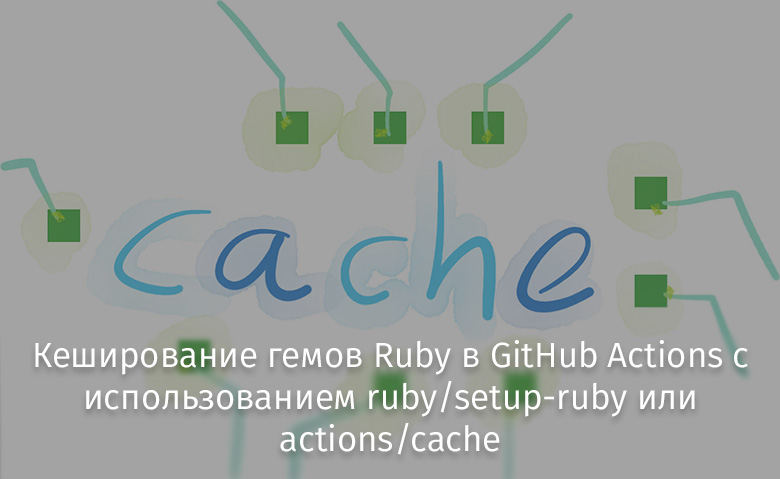ruby/setup-ruby
, and the second -
actions/cache
.
- actions / cache is a popular caching solution for Ruby gems.
- ruby/setup-ruby — , Ruby Ruby . , «» (, GitHub Actions «action»).

Actions/cache —
Actions / cache is a popular solution that can be used to place data in the cache and to retrieve it from the cache the next time the project build process starts in a CI system. This action is often used for RoR projects that also use an action to control Ruby versions in GitHub Actions
actions/setup-ruby
.
Let's consider an example of a configuration file for organizing caching in GitHub Actions, which uses
actions/cache
:
# .github/workflows/main.yml
name: Main
on: [push, pull_request]
jobs:
test:
runs-on: ubuntu-latest
steps:
- uses: actions/checkout@v2
- uses: actions/cache@v2
with:
path: vendor/bundle
key: ${{ runner.os }}-gems-${{ hashFiles('**/Gemfile.lock') }}
restore-keys: |
${{ runner.os }}-gems-
- name: Bundle install
env:
RAILS_ENV: test
run: |
bundle config path vendor/bundle
bundle install --jobs 4 --retry 3
Let's analyze the main features of this file:
- You need to specify the path to the directory that you want to cache. In our case, it is -
vendor/bundle
. - In addition, here we generate a unique
key
cache key ( ), using information about the operating system version and fileGemfile.lock
. Changing the operating system version or installing a new gemGemfile.lock
that causes the change will generate a new valuekey
. - Next, we need to configure the bundler so that it installs all our Ruby gems into the directory
vendor/bundle
. - Here you can use the following bundler parameters:
If you are interested in taking a look at the complete YAML files with GitHub Actions settings for Rail projects - here , here , there , here are some of our articles on this topic.
Ruby / setup-ruby - installing Ruby and caching gems
Above, we mentioned that it is often used in RoR projects
actions/setup-ruby
. But the action
actions/setup-ruby
was deprecated. It is recommended to use an action instead of it these days
ruby/setup-ruby
. In it, among other features, there is also the ability to cache data. This is what the configuration file looks like when it is intended to be used
ruby/setup-ruby
:
# .github/workflows/main.yml
name: Main
on: [push, pull_request]
jobs:
test:
runs-on: ubuntu-latest
steps:
- uses: actions/checkout@v2
- uses: ruby/setup-ruby@v1
with:
# .ruby-version
ruby-version: 2.7
# 'bundle install'
bundler-cache: true
# RSpec-
- run: bundle exec rspec
As you can see, this option for organizing gems caching is simpler than what we described in the previous section. And here, in addition, we have at our disposal the Ruby version control system. In essence, if we talk about caching gems, it all comes down to adding a line to the configuration file
bundler-cache: true
.
But what you can find out by referring to the documentation for
ruby/setup-ruby
:
, , , . , -, , - — . , , actions/cache ( — , , , .lock-, , , ABI- ruby-head ). , , , bundler-cache: true…
We've covered two ways to cache Ruby gems in CI GitHub Actions. We hope that anyone who needs to speed up building Ruby projects has found some food for thought here. But, of course, there are other ways to speed up CI pipelines, for example, parallel execution of tests.
Are you using GitHub Actions?
